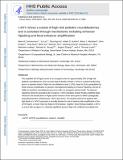c-MYC drives a subset of high-risk pediatric neuroblastomas and is activated through mechanisms including enhancer hijacking and focal enhancer amplification
Author(s)
Abraham, Brian J.; Young, Richard A.
Downloadnihms931203.pdf (1.150Mb)
Terms of use
Metadata
Show full item recordAbstract
The amplified MYCN gene serves as an oncogenic driver in approximately 20% of high-risk pediatric neuroblastomas. Here, we show that the family member MYC is a potent transforming gene in a separate subset of high-risk neuroblastoma cases (∼10%), based on (i) its upregulation by focal enhancer amplification or genomic rearrangements leading to enhancer hijacking, and (ii) its ability to transform neuroblastoma precursor cells in a transgenic animal model. The aberrant regulatory elements associated with oncogenic MYC activation include focally amplified distal enhancers and translocation of highly active enhancers from other genes to within topologically associating domains containing the MYC gene locus. The clinical outcome for patients with high levels of MYC expression is virtually identical to that of patients with amplification of the MYCN gene, a known high-risk feature of this disease. Together, these findings establish MYC as a bona fide oncogene in a clinically significant group of high-risk childhood neuroblastomas. SIGNIFICANCE: Amplification of the MYCN oncogene is a recognized hallmark of high-risk pediatric neuroblastoma. Here, we demonstrate that MYC is also activated as a potent oncogene in a distinct subset of neuroblastoma cases through either focal amplification of distal enhancers or enhancer hijacking mediated by chromosomal translocation. ©2018
Date issued
2018-03Department
Whitehead Institute for Biomedical Research; Massachusetts Institute of Technology. Department of BiologyJournal
Cancer discovery
Publisher
American Association for Cancer Research (AACR)
Citation
Zimmerman, Mark W., et al., "c-MYC drives a subset of high-risk pediatric neuroblastomas and is activated through mechanisms including enhancer hijacking and focal enhancer amplification." Cancer discovery 8, 3 (2018): p. 320-35 doi 10.1158/2159-8290.CD-17-0993 ©2018 Author(s)
Version: Author's final manuscript
ISSN
2159-8274
2159-8290
Collections
The following license files are associated with this item: